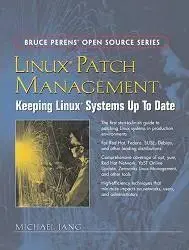Michael Jang | "Linux Patch Management - Keeping Linux Systems Up To Date"
Prentice Hall | Jan 2006 | ISBN: 0132366754 | English | CHM | 288 pages | Size (for download): 6.3 MB
It's important to keep Linux computers up to date. Linux developers are constantly updating key services to enhance security, add features you need, fix bugs that hinder your productivity and the productivity of your users, and help your systems to work more efficiently. These updates are known as patches. Most Linux distributions make gigabytes of patches available over the Internet. These updates cannot help you unless you know how to manage patches for the different Linux systems on your network.
This book assumes you have some sort of high-speed Internet connection that can help you download these patches. You may need to download hundreds of megabytes of patches, and that is not realistic on a 56Kbps telephone modem. If you have to download hundreds of megabytes on all the Linux computers in your office, you might overload all but the fastest business-quality high-speed connections.
In this book, I describe how you can manage patches on Red Hat/Fedora, SUSE, and Debian Linux systems. While Red Hat and SUSE have developed specialized update tools for their distributions, it's also possible to use community tools, such as apt and yum, on many Linux distributions.
To this end, you can use this book as a guide to managing patches on the noted distributions. In addition, you can use apt and yum on a number of other Linux systems. As a Linux administrator, you can use this book to learn to manage the hundreds of megabytes, or even gigabytes, of patches on a wide variety of Linux systems.
After you learn to manage patches on individual Linux systems, you can extend those skills to managing a group of Linux computers on a network. If you have a sufficient number of Linux systems, you may even want to build your own patch management repositories.
Patches on one or two Linux computers may work well with a standard high-speed Internet connection. If you have a substantial number of Linux computers, you might download the patches from each of these computers over the Internet. To keep these downloads from overloading your Internet connection, you can pay a premium for an even higher-speed connection.
Alternatively, you can use the techniques described in this book to configure a local patch management repository. This can help you avoid buying a faster high-speed Internet connection. Thus, a patch management repository can help you save a lot of money. In addition, you can update a group of computers more quickly when you download patches from a local repository.
TABLE OF CONTENT:
Chapter 1 - Patch Management Systems
Chapter 2 - Consolidating Patches on a Red Hat/Fedora Network
Chapter 3 - SUSE's Update Systems and rsync Mirrors
Chapter 4 - Making apt Work for You
Chapter 5 - Configuring apt for RPM Distributions
Chapter 6 - Configuring a yum Client
Chapter 7 - Setting Up a yum Repository



